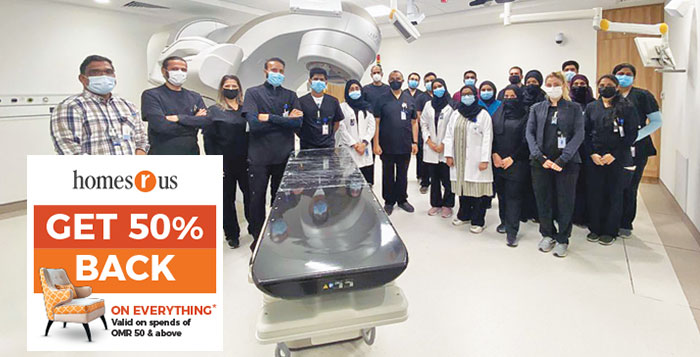
Muscat: New forms of treatment used in Oman to fight cancer can help cure patients of the disease in a far shorter time, and ensure patients suffer from less side effects during their recovery.
The team at Sultan Qaboos Comprehensive Cancer Care and Research Centre (SQCCCRC) used a process called the partial breast irradiation technique to treat breast cancer patients in the country.
The technique uses photon beams as a virtual scalpel to remove cancer cells, while ensuring healthy ones remain intact.
“This non-invasive technique speeds up treatment, allowing it to be completed in five sessions across ten days, instead of having a full treatment programme that may extend to between 15 and 30 sessions,” explained Dr Zahid Al Mandhari, a senior consultant in radiation oncology at SQCCCRC.
Al Mandhari, who is also a member of the centre’s operational committee, added, “This technology is used only in the early stages of breast cancer. It also helps to reduce side effects significantly, with clinical results identical to a full course of treatment.”
Another treatment employed is the Hypo-SIB technique, with a patient at SQCCCRC becoming the first to be treated in this manner at the centre. Under this treatment, patients are provided both radiation and complement doses in the same session.
This too helps reduce the sessions a patient requires to recover from cancer from 30 to 15 sessions.
“These two new techniques are considered the latest additions to our experience in treating cancer patients in Oman,” explained Al Mandhari.
Adding to this, Dr Iqbal Al Amri, of the Department of Therapeutic Medical Physics, said, “Such modern technologies require high accuracy in diagnosis and treatment planning. The centre has used cutting-edge devices and appropriately qualified staff to provide the highest levels of treatment and care for cancer patients.
“For instance, Surface-Guided Radiation Therapy (SGRT) uses sophisticated 3D camera technology, where the cameras monitor the exact position of the patient to make sure the radiation is targeted at the right areas and kills cancer cells precisely.”
As part of the soft opening of SQCCCRC, the centre began to welcome patients at its outpatient clinics, following the comprehensive care principle, which is carried out by a multidisciplinary team including oncologists, psychiatrists, dietitians and pharmacists.
These personnel visit the patient in the examination room individually, making them feel comfortable and taken care of. The centre is expected to receive about 80 percent of cancer patients within Oman.
There were about 2,118 reported cancer patients in 2018, according to figures released by the Ministry of Health in 2021. There were 1,911 Omanis with cancer: 836 of them were male, the other 1,075 were female.
The most common cancers found in Oman are breast cancer in women, followed by colorectal cancer and thyroid cancer, according to the Department of Non-Communicable Diseases at the Directorate General of Primary Health Care, represented by the National Cancer Registry.
The average age at which women are diagnosed with breast cancer is 48 years. 32 percent of breast cancer patients were diagnosed in the third and fourth stages of their condition, while there has been an increase in breast cancer incidence rates.